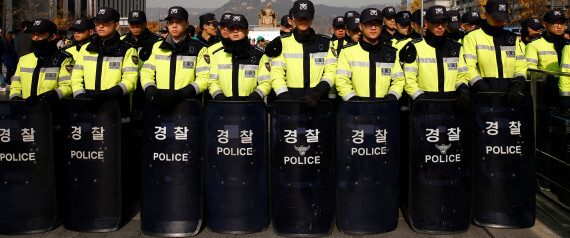hankyoreh
Links to other country sites 다른 나라 사이트 링크
Traffic, instead of security and intelligence, police officers to manage public demonstrations

Assemblies and demonstrations in South Korea are managed by intelligence police and security police. Intelligence police receive assembly reports and gather intelligence on demonstrators, while security police manage demonstrators and suppress clashes. Many have argued that the focus on “controls” under this approach needlessly provokes demonstrators.
Now the police have answered the Blue House‘s calls for more of a human rights focus by making plans to have traffic police rather than security police play a central role in managing assemblies and demonstrations.
“In the future, as long as there is judged to be no risk of a violent demonstration, it will mainly be traffic police managing the scene, while the role of security police will be confined to maintaining police lines,” a senior police official said in a May 29 telephone interview with the Hankyoreh.
“Security police will be on standby is unseen locations to respond to possible incidents,” the official added.
The official also noted that demonstrations have “become more peaceful since the candlelight demonstrations,” adding that there would be an “announcement of a general position shortly from the National Police Agency.”
At a demonstration organized on May 27 by the Korean Confederation of Trade Unions (KCTU) and others, the police mainly deployed traffic officers rather than riot police. The police also plan to assign traffic officer uniforms to security police positioned at demonstrations to maintain police lines. The measure effectively removes security police visually from scenes where they could potentially provoke demonstrators.
The police also appear poised to introduce a dialogue-based police system similar to one used by Swedish police, where officers communicate with participants at demonstrations and relay their demands to authorities.
“In the future, it is looking more and more like the police’s focus will shift toward allowing demonstration organizers to manage their own demonstrations independently,” said National Police Agency human rights protection officer Lee Dae-hyeong during a May 26 lecture meeting titled “Police and Human Rights Come Together” at the Busan Metropolitan Police Agency.
“There is a strong likelihood the police will adopt a more progressive approach along the lines of Sweden’s dialogue police,” Lee predicted.
A senior police official explained that the dialogue police system is “one of many approaches being considered for assemblies and demonstrations,” adding there would be “an announcement shortly.”
Byun Jeong-pil, who heads the human rights team for Amnesty International Korea, said the situation would require “ongoing monitoring.”
“The police are capable of simply declaring that they are going to change and then citing various reasons for restricting actual freedoms of assembly on the ground as they have done in the past,” Byun warned.
By Heo Jae-hyun, staff reporter
Please direct questions or comments to [english@hani.co.kr]

Editorial・opinion
![[Column] Park Geun-hye déjà vu in Yoon Suk-yeol [Column] Park Geun-hye déjà vu in Yoon Suk-yeol](https://flexible.img.hani.co.kr/flexible/normal/500/300/imgdb/original/2024/0424/651713945113788.jpg) [Column] Park Geun-hye déjà vu in Yoon Suk-yeol
[Column] Park Geun-hye déjà vu in Yoon Suk-yeol![[Editorial] New weight of N. Korea’s nuclear threats makes dialogue all the more urgent [Editorial] New weight of N. Korea’s nuclear threats makes dialogue all the more urgent](https://flexible.img.hani.co.kr/flexible/normal/500/300/imgdb/original/2024/0424/7317139454662664.jpg) [Editorial] New weight of N. Korea’s nuclear threats makes dialogue all the more urgent
[Editorial] New weight of N. Korea’s nuclear threats makes dialogue all the more urgent- [Guest essay] The real reason Korea’s new right wants to dub Rhee a founding father
- [Column] ‘Choson’: Is it time we start referring to N. Korea in its own terms?
- [Editorial] Japan’s rewriting of history with Korea has gone too far
- [Column] The president’s questionable capacity for dialogue
- [Column] Are chaebol firms just pizza pies for families to divvy up as they please?
- [Column] Has Korea, too, crossed the Rubicon on China?
- [Correspondent’s column] In Japan’s alliance with US, echoes of its past alliances with UK
- [Editorial] Does Yoon think the Korean public is wrong?
Most viewed articles
- 1[Guest essay] The real reason Korea’s new right wants to dub Rhee a founding father
- 2Why Korea shouldn’t welcome Japan’s newly beefed up defense cooperation with US
- 3[Column] ‘Choson’: Is it time we start referring to N. Korea in its own terms?
- 4New AI-based translation tools make their way into everyday life in Korea
- 5[Column] Park Geun-hye déjà vu in Yoon Suk-yeol
- 6Senior doctors cut hours, prepare to resign as government refuses to scrap medical reform plan
- 7Opposition calls Yoon’s chief of staff appointment a ‘slap in the face’
- 8Will NewJeans end up collateral damage in internal feud at K-pop juggernaut Hybe?
- 9Terry Anderson, AP reporter who informed world of massacre in Gwangju, dies at 76
- 10Thursday to mark start of resignations by senior doctors amid standoff with government